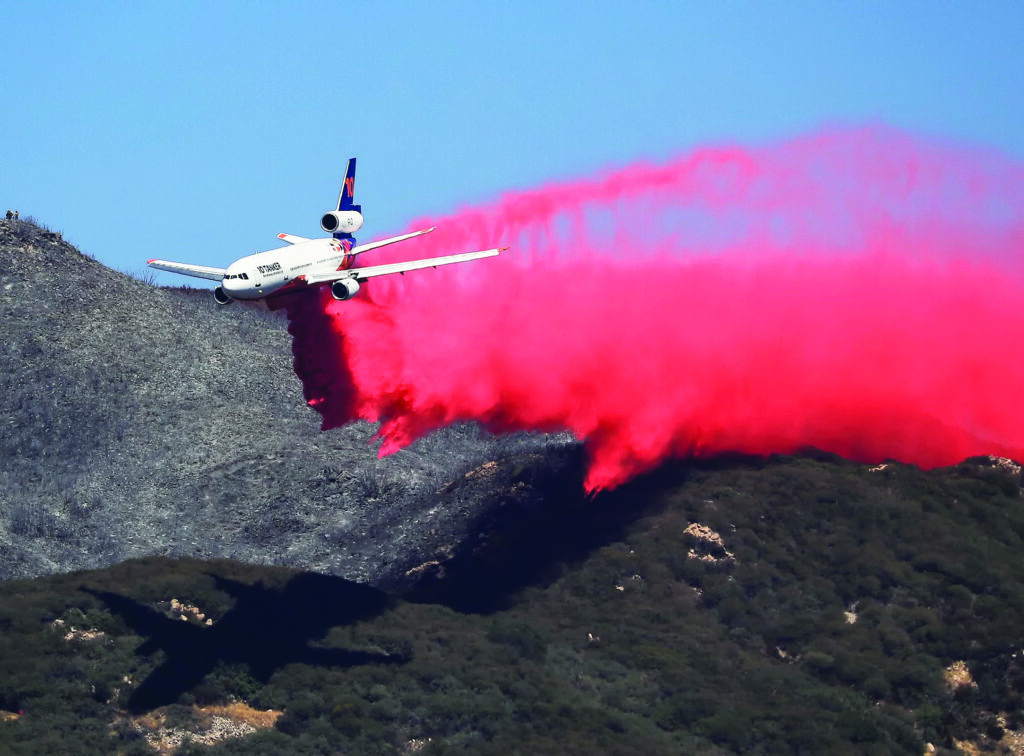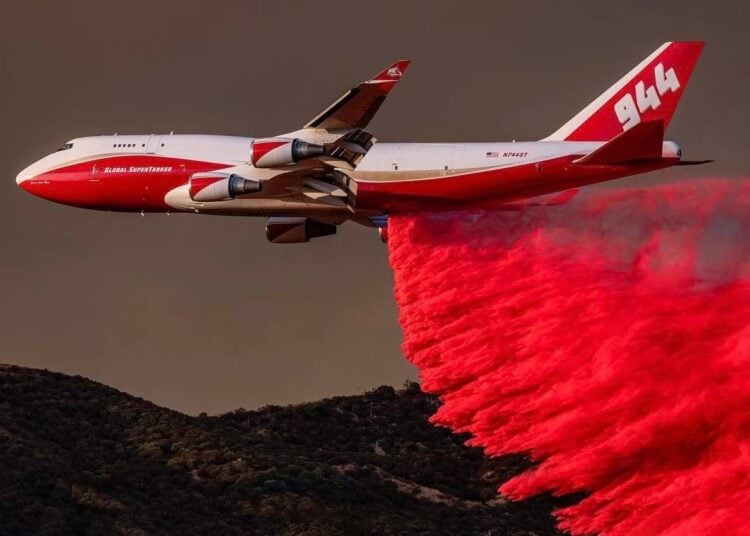PHOS-CHEK fire retardant was trademarked in 1963, making 2023 the 60th anniversary of the product. It also marked another milestone – 60 years that Perimeter Solutions, the makers of PHOS-CHEK, has worked with the U.S. Forest Service, according to Eddie Goldberg, Vice Chairman of Perimeter Solutions.
Goldberg says that Perimeter continues to use phosphates for the company's products as they are the most effective, safest, and most environmentally friendly chemical to use to prevent the spread of wildfires.
History
In the early 1950s, water was the only tool to fight fires. Water dropped from airplanes is surprisingly inefficient, and many realized over time that another solution was needed. Over the next decade, additives, including water thickeners, gums, and even clay, were used to make aerial firefighting more efficient.
In the late 1950s, the industry started adding the first chemical, sodium borate, to the mix. While effective, borate was found to be a soil sterilant and was quickly abandoned.
Previous studies showed ammonium phosphate as the most effective fire retardant chemical available. During that time, Monsanto, a large phosphate producer, was working with the USDA Forest Service to commercialize the use of ammonium phosphate in aerial firefighting. At that time, Monsanto was uniquely positioned to develop this technology and supply the large quantities needed to support the industry.

According to Goldberg, the unique aspect of phosphate-based products for aerial firefighting is that "phosphate works chemically, with the fuel, to change the way cellulose decomposes, rendering it non-flammable. Monsanto was a large phosphoric acid producer and had contracted with a large steel producer to supply phosphoric acid to scrub their stacks from ammonia. When you mix ammonia and phosphoric acid, you produce ammonium phosphate. So, Monsanto had a lot of ammonium phosphate on their hands. Using it as a fire retardant was mutually beneficial for both Monsanto and the Forest Service. That chemistry, along with ammonium sulfate chemistry, which works similarly but not nearly as effectively, became the standard in the industry starting in the early 1960s."
Goldberg says that the products the company sells today are far better than the products of 60–or even 20–years ago. In 1971, PHOS-CHEK became the first colored fire retardant, allowing pilots to see where they were dropping the retardant to form a continuous fire line. Later, "fugitive color" PHOS-CHEK was introduced. An important innovation, this made retardant fade away after being exposed to sunlight over a period of time. As the product evolved, better thickeners were developed to improve drop characteristics, more sophisticated corrosion inhibitors were added, enhanced flow conditioners made mixing easier and more efficient, and changes were made to improve its environmental profile.

PHOS-CHEK has been owned by multiple companies over the last 60 years, starting with Monsanto. The PHOS-CHEK business became part of Solutia when Monsanto divested its chemical businesses in 1997, and then in 2000, the business was acquired by Astaris, a joint venture between Solutia and FMC. Astaris was subsequently acquired by Israel Chemicals Limited (ICL) in 2005, and the PHOS-CHEK brand was assigned to ICL's Performance Products division. In 2018, ICL sold its Fire Safety and Specialty Additives businesses to SK Capital. Eddie Goldberg took the role of CEO of the newly formed Perimeter Solutions. In 2021, Perimeter Solutions as part of an acquisition by EverArc Holdings, went public and is now listed on the New York Stock Exchange (PRM).
"We flourished as part of Astaris and ICL, as the industry started to take off, and the air tanker fleet was rejuvenated. We formulated and commercialized world-class products, built our infrastructure to support the growing need, and became true partners with the agency. In 2007, we acquired the assets of FIRE-TROL® when they had trouble reformulating their products to remove a specific ingredient and we became the primary supplier to the US government. We've been working in partnership with them ever since," said Goldberg.
International Operations
While the United States is the largest market for Perimeter Solutions, its international markets are quickly growing. In addition to the US, the company has operations in Canada, Spain, France, Germany, and Australia in both its Fire Safety and Specialty Products businesses. In fire, Goldberg says the company will continue to grow worldwide as the threat of wildfire continues to grow.
The Future
When asked about the future of Perimeter Solutions and other growth areas for the company, Goldberg was very passionate about what lies ahead in the fast-paced industry. "You know, we're always looking forward in our research and development to see what improvements can be made to our products, and what new chemistries might be out there. We're currently launching our latest product, PHOS-CHEK LCE20-FX, a next-generation liquid concentrate. It'll eventually replace our LC95A product that has been a global industry standard for the last almost 20 years. LCE20-Fx is more effective and has a better environmental and toxicity profile. Overall, we think it's a much better product. It's more stable and doesn't require as much handling or maintenance in the field. We're really excited about PHOS-CHEK LCE20-Fx.
![]()
Of course, we'll continue to look for new products and chemistries that could be more effective and/or cost-effective than phosphates. We're always looking to the future. And it's not just around product innovation. It's also innovation of our services and our infrastructure. This industry is growing at quite a clip as the global wildfire problem worsens. Air tankers are getting bigger and faster. We have to be able to support them and we have to load them faster and load multiple airplanes simultaneously. The key is to turn them faster to make the fleet more effective.
So, we're continuing to invest in our tanker base technology. Not just the size of the tanker bases but how we mix and load the retardant to do it faster. We are investing in our distribution network to ensure that we continue to load every airplane that pulls into a pit. You may not know this, but tanker bases typically only have enough inventory to last about one day of operation. So, if you're in the Pacific Northwest, in Medford for example, you could have 10 Airplanes show up in one day, and now all of a sudden, you're flying, and you've got one day's worth of inventory. We're resupplying those bases 24/7/365 to ensure that we are always ready. We build and continuously improve our distribution network, to ensure 100% reliability. Overall, raw material supply, manufacturing and distribution takes a lot of investment and innovation, and we're doing that on a real-time basis," said Goldberg.
Looking Forward
Perimeter Solutions has, in addition to supporting operations at fixed bases, developed new technology for mobile retardant bases that support both fixed wing and helicopter operations close into the fires. These are mobile, wholly contained units that can be deployed to remote locations to bring the product closer to the firefight and bring down the amount of time aircraft need to spend in the air to get to their next load of retardant. This has been a game changer for agencies and aircraft using retardant on fires in remote areas.
Conclusion
While estimating the need for future infrastructure like mobile retardant bases and amounts of retardant used in a season around the world is much like estimating the length of a piece of string, Perimeter Solutions is doing an admirable job of thinking outside the box to provide better products and new and innovative technology that makes aerial firefighting more effective.






